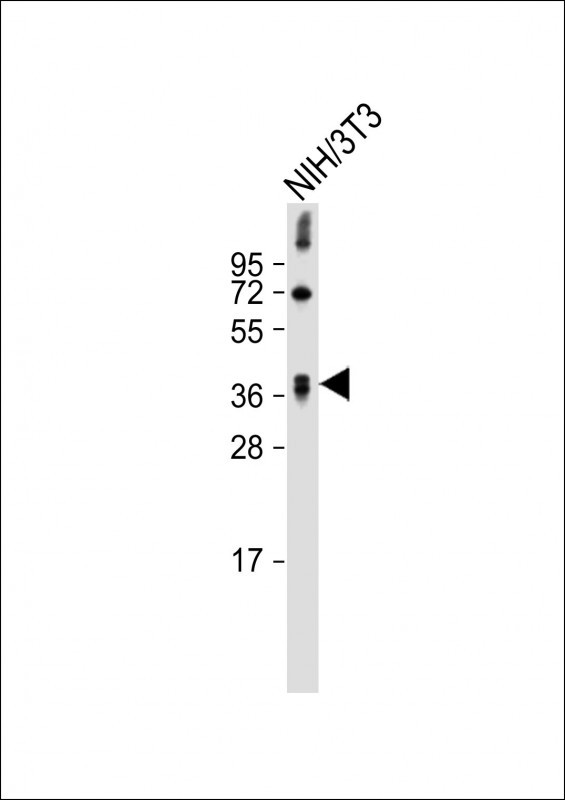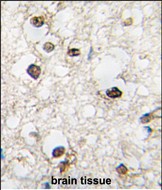QKI Antibody (N-term)
Affinity Purified Rabbit Polyclonal Antibody (Pab)
- 产品详情
- 实验流程
- 背景知识
Application
| IHC-P, WB, E |
|---|---|
| Primary Accession | Q96PU8 |
| Other Accession | Q5W9D5, Q9QYS9, Q5W9D7, Q6P104, Q32NN2 |
| Reactivity | Human, Mouse |
| Predicted | Xenopus, Zebrafish, Bovine, Mouse, Pig |
| Host | Rabbit |
| Clonality | Polyclonal |
| Isotype | Rabbit IgG |
| Calculated MW | 37671 Da |
| Antigen Region | 1-30 aa |
| Gene ID | 9444 |
|---|---|
| Other Names | Protein quaking, Hqk, HqkI, QKI, HKQ |
| Target/Specificity | This QKI antibody is generated from rabbits immunized with a KLH conjugated synthetic peptide between 1-30 amino acids from the N-terminal region of human QKI. |
| Dilution | IHC-P~~1:100~500 WB~~1:2000 E~~Use at an assay dependent concentration. |
| Format | Purified polyclonal antibody supplied in PBS with 0.05% (V/V) Proclin 300. This antibody is purified through a protein A column, followed by peptide affinity purification. |
| Storage | Maintain refrigerated at 2-8°C for up to 2 weeks. For long term storage store at -20°C in small aliquots to prevent freeze-thaw cycles. |
| Precautions | QKI Antibody (N-term) is for research use only and not for use in diagnostic or therapeutic procedures. |
| Name | QKI {ECO:0000303|PubMed:16342280, ECO:0000312|HGNC:HGNC:21100} |
|---|---|
| Function | RNA reader protein, which recognizes and binds specific RNAs, thereby regulating RNA metabolic processes, such as pre-mRNA splicing, circular RNA (circRNA) formation, mRNA export, mRNA stability and/or translation (PubMed:22398723, PubMed:23630077, PubMed:25768908, PubMed:27029405, PubMed:31331967, PubMed:37379838). Involved in various cellular processes, such as mRNA storage into stress granules, apoptosis, lipid deposition, interferon response, glial cell fate and development (PubMed:25768908, PubMed:31829086, PubMed:34428287, PubMed:37379838). Binds to the 5'-NACUAAY-N(1,20)-UAAY-3' RNA core sequence (PubMed:23630077). Acts as a mRNA modification reader that specifically recognizes and binds mRNA transcripts modified by internal N(7)-methylguanine (m7G) (PubMed:37379838). Promotes the formation of circular RNAs (circRNAs) during the epithelial to mesenchymal transition and in cardiomyocytes: acts by binding to sites flanking circRNA-forming exons (PubMed:25768908). CircRNAs are produced by back- splicing circularization of pre-mRNAs (PubMed:25768908). Plays a central role in myelinization via 3 distinct mechanisms (PubMed:16641098). First, acts by protecting and promoting stability of target mRNAs such as MBP, SIRT2 and CDKN1B, which promotes oligodendrocyte differentiation (By similarity). Second, participates in mRNA transport by regulating the nuclear export of MBP mRNA (By similarity). Finally, indirectly regulates mRNA splicing of MAG pre- mRNA during oligodendrocyte differentiation by acting as a negative regulator of MAG exon 12 alternative splicing: acts by binding to HNRNPA1 mRNA splicing factor, preventing its translation (By similarity). Involved in microglia differentiation and remyelination by regulating microexon alternative splicing of the Rho GTPase pathway (By similarity). Involved in macrophage differentiation: promotes monocyte differentiation by regulating pre-mRNA splicing in naive peripheral blood monocytes (PubMed:27029405). Acts as an important regulator of muscle development: required for the contractile function of cardiomyocytes by regulating alternative splicing of cardiomyocyte transcripts (By similarity). Acts as a negative regulator of thermogenesis by decreasing stability, nuclear export and translation of mRNAs encoding PPARGC1A and UCP1 (By similarity). Also required for visceral endoderm function and blood vessel development (By similarity). May also play a role in smooth muscle development (PubMed:31331967). In addition to its RNA-binding activity, also acts as a nuclear transcription coactivator for SREBF2/SREBP2 (By similarity). |
| Cellular Location | Nucleus. Cytoplasm [Isoform QKI6]: Cytoplasm, cytosol. Nucleus Note=Localizes predominantly in the cytoplasm and at lower levels in nucleus. |
| Tissue Location | Expressed in the frontal cortex of brain. Down- regulated in the brain of schizophrenic patients |
For Research Use Only. Not For Use In Diagnostic Procedures.
Provided below are standard protocols that you may find useful for product applications.
BACKGROUND
QKI belongs to a family of RNA-binding proteins that have an HNRNPK homology (KH) domain embedded in a 200-amino acid region called the GSG domain. Other members of this family include SAM68 (KHDRBS1) and SF1.
REFERENCES
Zhao,L., J. Neurosci. 26 (44), 11278-11286 (2006)
Haroutunian,V., Am J Psychiatry 163 (10), 1834-1837 (2006)
Aberg,K., Proc. Natl. Acad. Sci. U.S.A. 103 (19), 7482-7487 (2006)
终于等到您。ABCEPTA(百远生物)抗体产品。
点击下方“我要评价 ”按钮提交您的反馈信息,您的反馈和评价是我们最宝贵的财富之一,
我们将在1-3个工作日内处理您的反馈信息。
如有疑问,联系:0512-88856768 tech-china@abcepta.com.























 癌症的基本特征包括细胞增殖、血管生成、迁移、凋亡逃避机制和细胞永生等。找到癌症发生过程中这些通路的关键标记物和对应的抗体用于检测至关重要。
癌症的基本特征包括细胞增殖、血管生成、迁移、凋亡逃避机制和细胞永生等。找到癌症发生过程中这些通路的关键标记物和对应的抗体用于检测至关重要。 为您推荐一个泛素化位点预测神器——泛素化分析工具,可以为您的蛋白的泛素化位点作出预测和评分。
为您推荐一个泛素化位点预测神器——泛素化分析工具,可以为您的蛋白的泛素化位点作出预测和评分。 细胞自噬受体图形绘图工具为你的蛋白的细胞受体结合位点作出预测和评分,识别结合到自噬通路中的蛋白是非常重要的,便于让我们理解自噬在正常生理、病理过程中的作用,如发育、细胞分化、神经退化性疾病、压力条件下、感染和癌症。
细胞自噬受体图形绘图工具为你的蛋白的细胞受体结合位点作出预测和评分,识别结合到自噬通路中的蛋白是非常重要的,便于让我们理解自噬在正常生理、病理过程中的作用,如发育、细胞分化、神经退化性疾病、压力条件下、感染和癌症。







